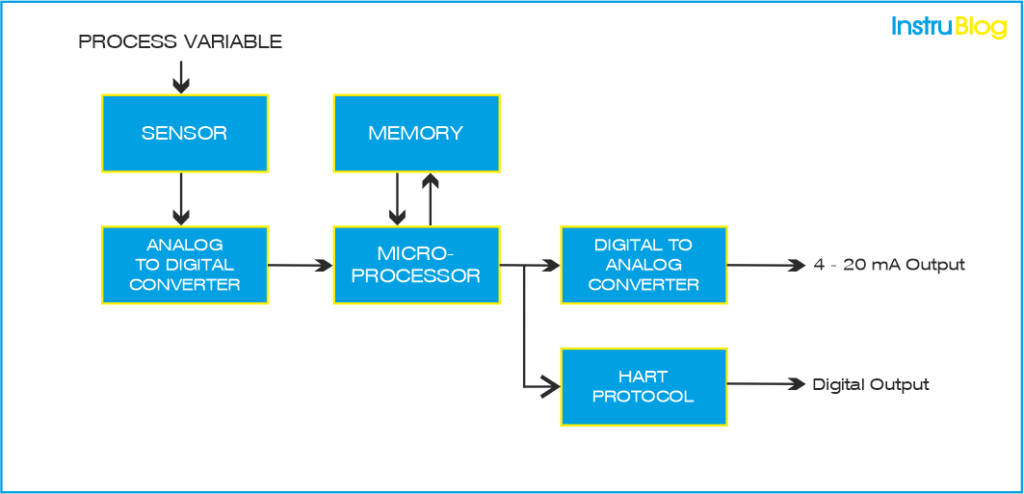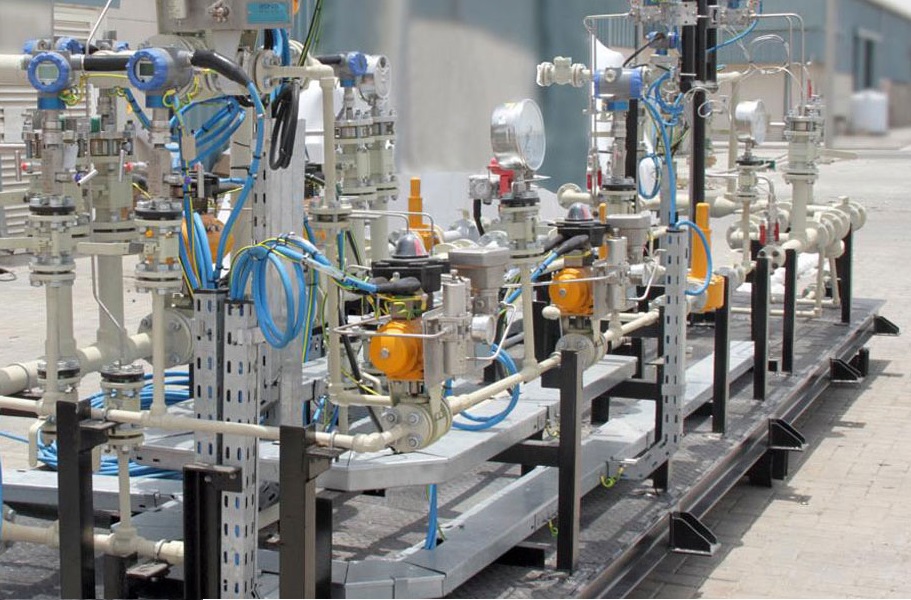What is a smart transmitter
Transmitters play a crucial role in measuring physical variables like temperature, pressure, and level. By converting the measured value into an electrical signal, transmitters enable easy monitoring and control. Typically, these devices produce output signals in the form of voltage ranges (0-5V, 0-10V) or current ranges (0-20mA, 4-20mA)
Although the regular transmitter may be functioning properly, industrial applications increasingly require greater precision, improved performance, and enhanced reliability. As a result, smart transmitters are becoming more valuable and relevant in today’s industrial settings.
A smart transmitter is an advanced device that incorporates a microprocessor as a built-in component. Unlike conventional transmitters, smart transmitters have their own memory and can be programmed according to specific requirements.
These intelligent devices have the capability to perform calculations, conduct self-diagnostics, and establish communication with other devices or systems. This allows for increased functionality, flexibility, and efficient data exchange in industrial processes.
A smart transmitter is a device equipped with a microprocessor that acts as its brain. It has its own memory and can be programmed to perform specific tasks. Smart transmitters can calculate measurements, perform self-diagnosis, and communicate with other devices.
These features make them highly versatile and valuable in various industrial applications.
The primary communication protocol used by smart transmitters to interact with other devices is the HART Protocol. HART stands for Highway Addressable Remote Transducer. It allows for two-way communication between the smart transmitter and other devices, enabling data exchange, remote configuration, and diagnostics.
The HART Protocol has become widely adopted in industrial settings for its versatility and compatibility with a wide range of equipment and systems.
A transmitter that is compatible with the HART protocol features two outputs: the traditional analog signal ranging from 0-10V or 4-20mA, as well as a digitally superimposed signal.
This dual-output capability allows for simultaneous transmission of both analog and digital signals.
Block Diagram:

Few integral parts of the smart transmitter
- Sensor or Transducer
- Analog to Digital Converter
- Micro-processor
- Digital to Analog Converter
- Digital Communication Protocol
A sensor or transducer is responsible for measuring physical signals from process variables like temperature, pressure, or level, and converting them into appropriate electrical signals. These electrical signals are then directed to an Analog to Digital Converter (ADC).
The role of the ADC is to transform the electrical signal into a digital count, which represents the process variable (PV). This digital count is then sent to a microprocessor for further processing.
The microprocessor’s primary function is to perform mathematical conversions on the digital count, generating an equivalent mA representation.
Depending on the manufacturer, the microprocessor may incorporate various algorithms. When we connect a handheld field communicator to the microprocessor, we can observe the digital representation of the desired output.
The output from the microprocessor is then directed to a Digital to Analog Converter (DAC), which converts the digital count into an actual analog electrical signal ranging from 4-20 mA. This output, also known as the current loop trip or 4-20 mA trim, reflects the desired output value.
Block diagram of the conventional analog transmitter

Please refer above block diagram of conventional analog transmitter.
The input signal from the sensor is directly passed to a set of electronics circuits within the transmitter. These circuits are responsible for converting the input signal into an appropriate electrical signal.
The output of the transmitter is typically in the form of a 4-20mA loop current, which can be utilized for various control and monitoring purposes.
What is differences between smart transmitter and conventional transmitter?
Communication:
The smart transmitter utilizes a digital communication protocol, often employing the HART protocol.
This advanced communication capability enables the smart transmitter to superimpose the analog signal, allowing for digital reading and enhanced communication between devices.
In contrast, the conventional transmitter relies on a 4-20mA loop current output, which lacks digital reading capabilities.
Accuracy:
When it comes to accuracy, the conventional transmitter has limitations.
The zero and span adjustment in the conventional transmitter is typically confined to a range of 2-3% of the fixed reading value.
However, the smart transmitter offers a significant improvement in accuracy. It provides a comprehensive display of parameters, including detailed information about zero and span adjustment, instrument loop identification, diagnostics, and multiple process variables.
This enhanced display and functionality contribute to improved accuracy and facilitate better monitoring and control.
Rangeability:
The rangeability, or turndown range, of a transmitter is an essential factor in its performance.
The smart transmitter outshines the conventional analog transmitter in this aspect. With a turndown rangeability of up to 100:1, the smart transmitter surpasses the limited rangeability of 15:1 or 20:1 typically found in conventional analog transmitters.
This expanded rangeability allows for a wider span of measurement and greater flexibility in various industrial applications.
Advantages of Smart Transmitter
Improved Accuracy and Repeatability:
Smart transmitters offer enhanced accuracy and repeatability compared to conventional transmitters. Their advanced digital technology allows for more precise measurements and reduces measurement errors.
Long-term Stability:
Smart transmitters are designed to maintain long-term stability, ensuring reliable and consistent performance over extended periods. This stability is crucial for critical process control and monitoring applications.
Minimal Maintenance Cost:
Smart transmitters generally require minimal maintenance, resulting in cost savings for industries. Their robust construction and self-diagnostic capabilities reduce the need for frequent calibrations and inspections.
Remote Calibration and Re-ranging:
One of the key advantages of smart transmitters is the ability to remotely calibrate and re-range them. This feature eliminates the need for manual adjustments on-site, saving time and effort during maintenance operations.
Built-in Memory for Calibration Information:
Smart transmitters have their own memory to store calibration information. This enables easy access to the details of the last calibration, facilitating traceability and simplifying auditing processes.
Self-Calibration and Self-Diagnosis:
Smart transmitters incorporate self-calibration and self-diagnosis functionalities. They can automatically adjust and calibrate themselves, ensuring optimal performance and accuracy. Additionally, they can detect faults or anomalies in the measurement system, alerting operators to potential issues.
Fault Detection Approach:
Smart transmitters employ advanced fault detection mechanisms to identify any irregularities or malfunctions in the measurement process. This proactive approach helps prevent process disruptions, reduce downtime, and improve overall system reliability.
I hope you like above blog. There is no cost associated in sharing the article in your social media. Thanks for reading!! Happy Learning!!

